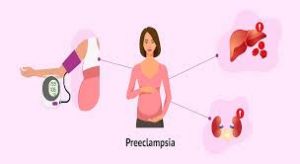Preeclampsia:

World Preeclampsia Day (May 22) was observed, to increase awareness about preeclampsia.
- Preeclampsia is a serious condition that develops during pregnancy, usually after 20 weeks or so.
- It is often marked by high blood pressure and protein in the urine and this condition can also affect other organs of the body including the kidneys, liver and brain.
- Untreated preeclampsia can have serious, even fatal consequences for the mother and baby.
- In some women, preeclampsia may develop after the delivery of the baby; this is known as postpartum preeclampsia.
- The exact cause of preeclampsia remains unknown, but researchers believe it may have come from a problem with the health of the placenta(the organ that develops in the uterus during pregnancy and is responsible for providing oxygen and nutrients to the fetus).
- Many people with preeclampsia do not have any symptoms.
- For those that do, some of the first signs of preeclampsia are high blood pressure, protein in the urine and retaining water (this can cause weight gain and swelling).
- Other signs of preeclampsia include Headaches, Blurry vision or light sensitivity, Dark spots appearing in your vision, Right side abdominal pain, Swelling in your hands and face (edema) and Shortness of breath.
- The only cure for preeclampsia is to give birth.
- Even after delivery, symptoms of preeclampsia can last 6 weeks or more.
- Treatment, if necessary, is based on how far along the pregnancy is, and may include induced labor or a Caesarean section (C-section).




